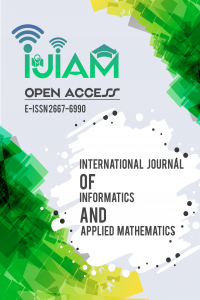K-means Clustering in R Libraries {cluster} and {factoextra} for Grouping Oceanographic Data
K-means Clustering in R Libraries {cluster} and {factoextra} for Grouping Oceanographic Data
R, programming language, statistics, geospatial data, k-means clustering, cluster analysis, data grouping marine geology,
___
- Ciaccio, A.D., Coli, M., Angulo Ibanez, J.M.: Studies in Theoretical and Applied Statistics Selected Papers of the Statistical Societies, chap. Advanced Statistical Methods for the Anaysis of Large Data Sets, p. 464. Springer (2012). https://doi.org/10.1007/978-3-642-21037-2
- Cielen,D., Meysman, A. D. B., M., A.: Introducing Data Science. Big Data, Machine Learning and More, Using Python Tools. Manning, Shelter Island, U.S. (2016)
- van Haren, H., Berndt, C., Klaucke, I.: Ocean mixing in deep-sea trenches: New insights from the Challenger Deep, Mariana Trench. Deep-Sea Research Part I: Oceanographic Research Papers (2017). https://doi.org/10.1016/j.dsr.2017.09.003
- Hartwell, A.M., Voight, J.R., Wheat, C.G.: Clusters of deep-sea egg-brooding octopods associated with warm fluid discharge: An ill-fated fragment of a larger, discrete population? Deep-Sea Research Part I: Oceanographic Research Papers 135, 1–8 (2018). https://doi.org/10.1016/j.dsr.2018.03.011
- Hessler, R.R., Ingram, C.L., Yayanos, A.A., Burnett, B.: Scavenging amphipods from the floor of the Philippine Trench. Deep-Sea Research Part I: Oceanographic Research Papers 25, 1029–1047 (1978)
- Ichino, M.C., Clark, M.R., Drazen, J.C., Jamieson, A., Jones, D.O.B., Martin, A.P., Rowden, A.A., Shank, T.M., Yancey, P.H., Ruhl, H.A.: The distribution of benthic biomass in hadal trenches: A modelling approach to investi- gate the effect of vertical and lateral organic matter transport to the seafloor. Deep-Sea Research Part I: Oceanographic Research Papers 100, 21–33 (2015). https://doi.org/10.1016/j.dsr.2015.01.010
- Itoh, M., Kawamura, K., Kitahashi, T., kiKojima, S., Katagiri, H., Shimanaga, M.: Bathymetric patterns of meiofaunal abundance and biomass associated with the Kuril and Ryukyu trenches, western North Pacific Ocean. Deep-Sea Research Part I: Oceanographic Research Papers 58, 86–97 (2011). https://doi.org/10.1016/j.dsr.2010.12.004
- Jamieson, A.J., Fujii, T.: Trench Connection. Biology Letters 7, 641–643 (2011). https://doi.org/10.1098/rsbl.2011.0231
- Jamieson, A.J., Fujii, T., Mayor, D.J., Solan, M., Priede, I.G.: Hadal trenches: the ecology of the deepest places on Earth. Trends in Ecology and Evolution 25(3), 190–197 (2009). https://doi.org/10.1016/j.tree.2009.09.009
- Michel, V., Gramfort, A., Varoquaux, G., Eger, E., Keribin, C., Thirion, B.: A supervised clustering approach for fMRI-based inference of brain states. Patt Rec (2011). https://doi.org/10.1016/j.patcog.2011.04.006
- Myers, J.L., Well, A.D.: Research Design and Statistical Analysis. Lawrence Erlbaum, 2 edn. (2003)
- R Development Core Team: R: a language and environment for statistical computing. R Foundation, Vienna, Austria (2014), available at http://www.R-project.org
- Roberts, N.M., Tikoff, B., Davis, J.R., Stetson-Lee, T.: The utility of statis- tical analysis in structural geology. Journal of Structural Geology pp. 1–39 (2018). https://doi.org/10.1016/j.jsg.2018.05.030, reference: SG 3671; PII: S0191-8141(17)30339-5
- Romankevich, E.A., Vetrov, A.A., Peresypkin, V.I.: Organic matter of the World Ocean. Russian Geology and Geophysics 50, 299–307 (2008). https://doi.org/10.1016/j.rgg.2009.03.013
- Marques de Sa ́, J.P.: Applied Statistics Using SPSS, Statistics, Matlab and R. Springer, Porto, Portugal, 2 edn. (2007), library of Congress Control Number: 2007926024
- Stewart, H.A., Jamieson, A.J.: Habitat heterogeneity of hadal trenches: Considerations and implications for future studies. Progress in Oceanography 161, 47–65 (2018). https://doi.org/10.1016/j.pocean.2018.01.007
- Swan, A.R.H., Sandilands, M. Introduction to Geological Data Analysis. Blackwell Science, Cambridge, Mass., USA (1995), Library of Congress: QE33.2.S82S931995; Dewey Decimal Classification (UDC): 550/.72
- Vermeesch, P., Resentini, A., Garzanti, E.: An R package for statistical provenance analysis. Sedimentary Geology 336, 14–25 (2016). https://doi.org/10.1016/j.sedgeo.2016.01.009
- Webb, T.J., Berghe, E.V., O‘Dor, R.: Biodiversity’s Big Wet Secret: The Global Distribution of Marine Biological Records Reveals Chronic Under-Exploration of the Deep Pelagic Ocean. PlosOne 5, 1–6 (8 2010). https://doi.org/10.1371/journal.pone.0010223
- Xu, Y., Ge, H., Fang, J.: Biogeochemistry of hadal trenches: Recent developments and future perspectives. Deep-Sea Research Part II: Topical Studies in Oceanography 155, 19–26 (2018). https://doi.org/10.1016/j.dsr2.2018.10.006
- Yancey, P.H., Gerringer, M.E., Drazen, J.C., Rowden, A.A., Jamieson, A.: Marine fish may be biochemically constrained from inhabiting the deepest ocean depths. PNAS (Proceedings of the National Academy of Sciences of the United States of America) 111, 4461–4465 (2014). https://doi.org/10.1073/pnas.1322003111
- Başlangıç: 2018
- Yayıncı: International Society of Academicians
Physical structure extraction of Algerian baccalaureate transcripts
Abderrahmane KEFALİ, Ahlem OBEİZİ, Chokri FERKOUS
K-means Clustering in R Libraries {cluster} and {factoextra} for Grouping Oceanographic Data
Security of Smart-Meters against Side-Channel-Attacks (SCA)
İqra MUSTAFA, Adeel ANJUM, Kouahla ZİNEDDİNE
A New Process for Background Subtraction based on AIRS
Wafa NEBİLİ, Samir HALLACİ, Brahim FAROU
A Multiple-Place Algorithm for Sustainable Foraging Scenarios
